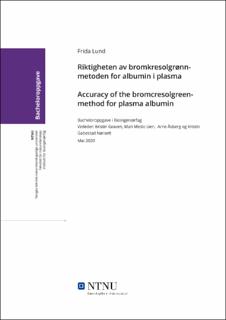| dc.contributor.advisor | Graven, Kristin | |
| dc.contributor.advisor | Lien, Mari Meslo | |
| dc.contributor.advisor | Åsberg, Arne | |
| dc.contributor.advisor | Nørsett, Kristin Gabestad | |
| dc.contributor.author | Lund, Frida | |
| dc.date.accessioned | 2020-07-07T16:09:26Z | |
| dc.date.available | 2020-07-07T16:09:26Z | |
| dc.date.issued | 2020 | |
| dc.identifier.uri | https://hdl.handle.net/11250/2661288 | |
| dc.description.abstract | På St. Olavs Hospital i Trondheim, benyttes bromkresolgrønn (BCG) metoden til måling av
albumin. Denne metoden har i tidligere studier vist en tendens til å overestimere
albuminkonsentrasjonen i lave nivåer (<30 g/L) og i henhold til det også kunne føre til
feildiagnostikk. Derfor ble en metodesammenligning utført mellom brokresolgrønn metoden
og den immunnefelometriske (IN) metoden, der IN-metoden ble brukt som referansemetode.
Albumin har to hovedfunksjoner i kroppen, som transportprotein og som opprettholder av det
kolloidosmotiske trykket. Måling av albuminkonsentrasjonen i plasma og serum er derfor en
mye brukt rutineanalyse. Kjennskap til albuminkonsentrasjonen er viktig for diagnostikk av
lever- og nyresykdommer, for bedømming av hydreringsgrad og ødemtilstander, og for
vurdering av ernæringsstatus.
Metodesammenligningen mellom BCG-metoden og IN metoden viste at det både var en
proporsjonal og konstant forskjell mellom metodene. I tillegg hadde BCG-metoden en
tendens til å overstimulere albuminkonsentrasjonen i forhold til IN-metoden, ikke bare i det
lave området, men over hele måleområdet. I det lave albuminnivået var overestimeringen til
BCG-metoden høyere enn i det høye albuminnivået >30 g/L. På grunn av dette øker
forskjellen mellom metodene med fallende albuminkonsentrasjon.
Det ble uført en multippel lineær regresjon for å se om faktorer som alder, kjønn,
kreatininkonsentrasjon og gjennomsnittsnivå albumin kunne være med å forklare
sammenhengen mellom metodene ytterligere. Av disse faktorene var det bare
gjennomsnittsnivå albumin som var statistisk signifikant. Siden spredningen rundt
regresjonslinjen ikke var konstant ble gjennomsnittsnivå albumin delt i to grupper, en <30 g/L
og en >30 g/L. Funksjonen av differansen mellom metodene og gjennomsnittsnivå albumin
var statistisk signifikant for albuminnivå >30 g/L.
Det er en usikkerhet rundt kvantiteringen av spredningen mellom metodene, siden
spredningen var større ved lavere albuminverdien enn ved høye. | |
| dc.description.abstract | At St. Olavs Hospital in Trondheim, the bromocresolgreen (BCG) method is used to measure
albumin. In previous studies this method tended to overestimate albumin concentrations at
low levels (<30 g/L). According to that, it can also lead to misdiagnosis. Therefore, a method
comparison was made between the bromocresolgreen method and the immuno-nephelometric
(IN) method with the IN-method as the reference method.
The major functions of albumin in the body is as a transport protein and as a maintainer of the
colloidal oncotic pressure. Measurement of the albumin concentration in plasma and serum is
therefore widely used in routine analysis. Knowledge of the albumin concentration is
important for the diagnosis of liver and kidney diseases, for the assessment of the degree of
hydration and edema conditions, and for the assessment of nutritional status.
The method comparison between the BCG- and the IN method, showed that it was both a
proportional and a constant difference between the two methods. In addition, the BCGmethod tends to overstimulate albumin concentration relative to the IN method. At low album
ranges <30 g/L, the overstimulation of the BCG method is larger than in the high album
ranges > 30 g/L. Because of this, the difference between the methods increases with
decreasing albumin levels.
Multiple linear regression was applied to see if factors such as age, gender, creatinine
concentration and albumin level could further explain the relationship between the methods.
Of these factors, only albumin levels were statistically significant. Since the spread around the
regression line was not constant, the albumin level was divided into two groups, one of <30
g/L and the second one of > 30 g/L. The function of the difference between the methods and
the average albumin level was statistically significant for the group >30 g/L.
There is some uncertainty about the quantitation of the spread between the methods since the
spread was greater at the low albumin values than at high albumin values. | |
| dc.publisher | NTNU | |
| dc.title | Riktigheten av bromkresolgrønn-metoden for albumin i plasma | |
| dc.type | Bachelor thesis | |
